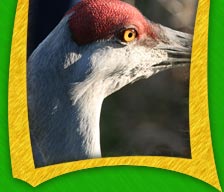|
LONG AND LEAN
With their light colored plumage and impressive size, these birds
are easy to spot. Most cranes possess streamlined bodies with
elongated legs and neck, broad feet, and a patch of bare red
skin on the head. The preferred locations to feed, nest and roost
are areas with minimal human contact such as grassy open fields
near freshwater lakes and marshlands. Mothers always want the
best for their kids and cranes are no different. Sandhills construct
several nests, but eventually choose one in which to lay their
eggs. No picky eaters here! As opportunistic feeders, cranes
consume a variety of plant and animal foods including nuts, grains,
insects, amphibians, small rodents and even crustaceans.
CALLING ALL CRANES
Their sound has been described as trumpet-like and at times, haunting.
Cranes have powerful vocal capabilities which allow them to communicate
with each other. As chicks, these birds can produce a variety
of sounds such as contact calls, stress calls, and hunger calls.
Within the first year, juveniles also learn the important “flight-intention
call.” This alerts other members of the flock to prepare
for flight. As cranes mature, the voice deepens and gains strength
in volume, thus enabling calls to be heard over vast distances.
One of the most dramatic calls happens as a duet. “Unison
calls” occur with mated pairs and are usually heard prior
to the breeding season. Generally, this type of auditory response
is meant to intimidate potential intruders, establish specific
territories, and initiate and maintain pair bond relationships.
Whooping cranes get their name from the “whooping-like” sound
they create.
TALL BIRD, LOW NUMBERS
As a result of over hunting and habitat loss, only 21 whooping
cranes existed in North America during the 1940’s. Despite
its strong presence throughout history and folklore, most species
of cranes are now considered endangered. Sometimes it’s
a case of mistaken identity. Because fall migrations normally
coincide with specific hunting seasons, hunters have mistaken
Whooping cranes for Snow Geese. Unfortunately for the cranes,
the mistake is often fatal. Nest and brood predators are mainly
raccoons, Bald Eagles, and Black Bears. However, man-made objects
pose the greatest threat to migrating flocks. Cranes have been
known to collide or become entangled with communication towers
and power lines. These issues coupled with slow reproductive
rates are factors that have kept populations low.
LET’S DANCE!
To attract a potential mate, cranes can really shake it up! During
social events like courting rituals, synchronized dances are
commonly performed. This elaborate movement, which consist of
short flights, leaps, and bows with wings extended are also a
way to relieve stress and just have fun. In the excitement of
the moment, cranes are known to pick up and toss with their beak
sticks, feathers, grass, and other random objects. Dancing, it’s
contagious! Once a few cranes begin to dance, additional members
of the flock will join the excitement and partake
in this flamboyant activity.
Resources for this article have been provided
by the Journey
North, North
American Crane Working Group and
the Florida Fish
and Wildlife Conservation Commission.
|











